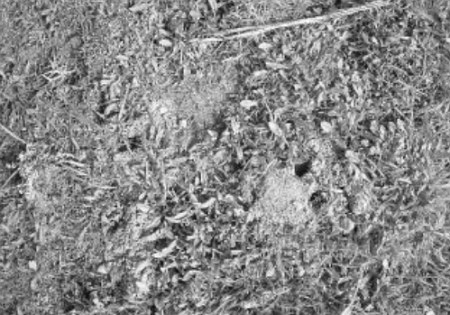Minotaur beetles Typhaeus typhoeus in Colchester, Essex
Maria Fremlin
Inspired by Lisa Webb's article 'The Dung Beetles of Ayrshire, Scotland' (AES Bulletin, Vol 63, No 456, pp 131-5) we decided to set up some traps to have a good look at that elusive nocturnal beetle Typhaeus typhoeus. Given that they feed on rabbit droppings Lisa's buckets were scaled down, and we used polystyrene drinking cups and 7.5 cm flower pots instead.
Four of these were sunk to ground level in a small area. The bait, rabbit droppings, was placed on a little plastic dish tied to a plastic garden trellis, 5 cm square, secured on top of the traps. However we soon found that we could easily trap the beetles if we cleared the rabbit droppings in the vicinity and simply placed them in the pots. This way the whole set up was simpler and much less eye catching. This was important because the area being monitored (approximately 8m x 12m in the Spinney, Hilly Fields, Colchester) is a popular public park.
This was done in late March 2005, when minotaur beetles were still active.
These beetles dig 1.5 metre deep tunnels, sometimes with a branch at the top, so that one can see two holes - approximately 1.6 cm - close together (see photo 1). They take the dung down to three or four side tunnels, lay an egg in each and leave them; unlike some dung beetles their offspring get no parental care. The interesting thing about minotaur beetles is that they are active in the evenings and when it gets very hot or dry they aestivate, ie, they enter a period of no activity at all, and then become active again in the autumn. In mild winters they emerge in February which is when we first saw signs of activity in the area, and by the end of April they had quietened down.

Photo 1 - Minotaur beetle burrows
They prefer grassy sunny places with good drainage and the area that we have studied had a nice sandy loamy soil. In it we found 12 fresh holes. In one trap we caught three females plus two males (see photo 2), and a female in another trap. All were released as soon as found. The trapping confirmed the existence of these beetles in that area. The males have some horns and are smaller than the females - 15 to 24 mm (see photos 3 and 4). I am not sure how long is their lifecycle, though. Do they lay eggs twice a year? I would also love to see the male rolling the rabbit pellets backwards with his hind legs. I understand that Minotaur beetles are the only "roller" species in the British Isles; the female does most of the digging though.

Photo 2 - Pitfall tap contents

Photo 3 - Male and female minotaur beetles (Typhaeus typhoeus)

Photo 4 - Male minotaur beetle (Typhaeus typhoeus)
By the way, did you know that the Egyptians imagined that their god, Khepri, a sacred dung beetle, rolled the sun across the sky from east to west each day? On the topic of gods, Minotaur in Greek mythology, was a creature half man half bull confined in a labyrinth who was eventually slain by Theseus . As for their scientific name, Typhaeus is the Latin name of a giant who was struck with lightning by Jupiter, also a mythological figure.
Originally published in the Volume 64 of the Bulletin of the Amateur Entomologists' Society.Corrections by the author who wishes to apologise for some inaccuracies
There is great size variation in both sexes, 12-20mm.
Minotaur beetles emerge in late September, after rains, then undergo a maturation feeding period in order to reach sexual maturity, and if the weather is mild they may start nesting in December. They pair up and nest in deep tunnels; in a side branch they lay a single egg at the time, then, at a short distance, make a brood mass with dung for the larva to feed on; this is unlike most Geotrupidae which lay inside their brood mass.
However, all of them hold the dung with their front legs and drag it backwards towards their nests. They have low fertility, will lay only up to 12 eggs; possibly they only nest once and by mid-July it is completed, after that they die, hence the adults do not aestivate. Their life cycle probably takes two years in this area. They are what one could call a "winter beetle".
Back to articles list.
![Amateur Entomologists' Society home page [Logo]](/images/aes-logo-wplant.gif)